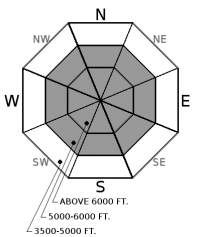| Monday | Monday Night | Tuesday | |
|---|---|---|---|
| Cloud Cover: | Light to moderate snow | Light snow ending | Clearing |
| Temperatures: | 33 to 38 deg. F. | 20 to 25 deg. F. | 35 to 40 deg. F. |
| Wind Direction: | W | SW | SW |
| Wind Speed: | 5 to 10 mph | 0 to 10 mph | 5 to 10 mph |
| Snowfall: | 2 to 4 in. | 1 to 3 in. | 0 in. |
| Snow Line: |
Whitefish Range
Swan Range
Flathead Range and Glacier National Park
How to read the forecast
Snow and wind returned to our area overnight increasing the avalanche danger. Storm slabs are forming on a variety of surfaces and will continue to thicken through the day. Note storm snow totals and watch for instabilities in the new snow. Evaluate all consequential terrain before committing to a slope.

3. Considerable
?
Above 6500 ft.
2. Moderate
?
5000-6500 ft.
2. Moderate
?
3500-5000 ft.
- 1. Low
- 2. Moderate
- 3. Considerable
- 4. High
- 5. Extreme
-
Type ?
-
Aspect/Elevation ?

-
Likelihood ?CertainVery LikelyLikelyPossible
 Unlikely
Unlikely -
Size ?HistoricVery LargeLargeSmall

Southwest winds and up to 10" of warm snow overnight are forming storm slabs on a variety of surfaces. On sunny aspects, slabs are resting on a sun crust which may act as a slick bed surface allowing resulting slides to travel long distances. Dry settled powder and isolated areas of surface hoar exist beneath the new snow on shady aspects. Continued snow and southwest winds will thicken slabs today especially on leeward aspects. This is a surface problem that can be identified by hand pits and cracking beneath you or your machine. Evaluate storm snow totals and all consequential terrain before committing to a slope.
After a week of dealing with wet avalanche problems, we need to regroup and remember how to deal with new snow instabilities. A potent storm moved into our area last night favoring the Swan Range (with over 2" of SWE) and Northern Whitefish Range (with over 1" of SWE). Relatively warm temperatures and light to moderate southwest winds are ideal for storm slab development...or for plastering the snow in solid! We won't know which way this storm slab problem will turn out until we get out in the field today. Regardless, this rapid load raises an orange flag - bring a conservative mindset into the backcountry today because natural or human-triggered slides could be large enough to cause harm. The storm is trending warm to cooler, which may help the new snow adhere to the stout sun crust on sunny aspects and limit instabilities. Carefully assess bonding on a slope by slope basis. With continued wind and snow slabs will thicken today, especially on leeward slopes. Look for instabilities in the new snow and evaluate all consequential terrain before committing to a slope today.
A storm system affecting our area will wind down later today with lingering light snow overnight. Tomorrow looks to be a pleasant dry day.
This advisory applies only to backcountry areas outside established ski area boundaries. This advisory describes general avalanche conditions and local variations always occur. This advisory expires at midnight on the posted day unless otherwise noted. The information in this advisory is provided by the USDA Forest Service who is solely responsible for its content.
















